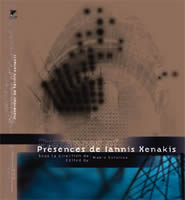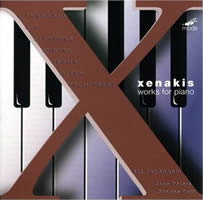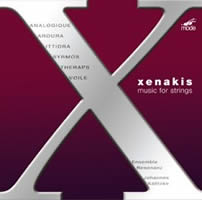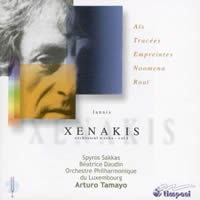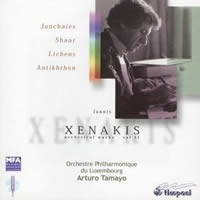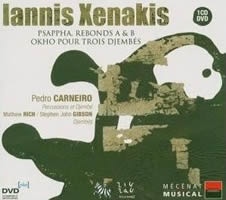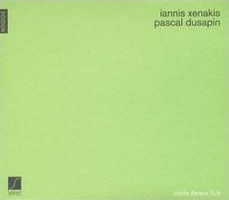New and Essential Xenakis, Part 1
|
Grant Chu Covell [October 2006.] From an American CD review:
Not everyone has to like Xenakis, though I wish everyone would. Be that as it may, it astonishes me that he can still generate such infantile responses. I take special exception in the cited instance to the journal’s editor, who should have had the sense to tap a more sympathetic reviewer. However, this “Xenophobe” (Xenakis means “little stranger” in Greek) does make a valid point: War was a fundamental influence. Much of this exile’s music relives a period’s chaos and brutality. He lost an eye fighting Fascists and, until 1974, would have been executed had he returned to his homeland. Nature is another theme, especially from the perspective of classical literature: the Iliad’s battlefields and the Odyssey’s wine-dark seas. Anger and pain pervade. Astonishingly, Xenakis once revealed a fondness for Brahms because, among other reasons, he was unable to compose similarly. Indeed, Xenakis is Brahms’ antithesis. While not all Xenakis recordings are essential listening, he wrote much the difficulties of which are only now becoming manageable, and for this alone, most every new recording warrants celebration. Here’s the first of two helpings of recent releases and ongoing series, plus some obscure items thrown in as lagniappe. Among this batch, my favorite track is Jonchaies; a favorite disc, mode’s re-release of piano works.
James HARLEY: Xenakis: His Life in Music. Routledge, 2004. ISBN 0-415-97145-4, xii + 279 pages (http://www.routledge.com/). Makis SOLOMOS, ed.: Présences de Iannis Xenakis [Presences of Iannis Xenakis]. Centre de Documentation de la Musique Contemporaine, 2001. ISBN 2-9516440-1-9, 268 pages (http://www.cdmc.asso.fr/). The serious Xenakis fan must acquire Harley’s book. Weaving history and analysis, Harley covers every stylistic adventure, piece and project. The compositions take priority. The biographical thread frequently vanishes — Xenakis’ failing health is delegated to footnotes. Nouritza Matossian’s 1986 biography, essential for the composer’s formative years and his work in Le Corbusier’s atelier, will be less frequently consulted where music is concerned. Unlike most listeners, Harley has had access to the scores. His descriptions by measure number may frustrate, but he also cites aural signposts. Because Harley can relate pieces chronologically and contextually, his insights surpass most program notes. He also insists that one need not be a mathematician, architect or scientist to enjoy or analyze Xenakis, providing explanations easier to navigate than the composer’s own in Formalized Music. Welcome revelations abound. I’m dumbfounded that I’ve never noticed that the 1996 duet for violin and cello, Hunem-Iduhey, takes its title from the dedicatee’s name in reverse. Serious English-language writings about Xenakis are rare. Perspectives of New Music sprinkled several Xenakis-related remembrances and articles across three issues in 2001 and ’02. Issued in paperback, the dual-language Présences de Iannis Xenakis [Presences of Iannis Xenakis] collects scholarly essays on multiple aspects of Xenakis’ work, with articles appearing in French or English. Harley’s valuable contribution categorizes late orchestral works. One section offers essays on Xenakis’ architecture and polytopes. The analyses tackle pieces recordings of which are available. It’s interesting to see traditional musicology, spectral analyses, and mathematics brought to bear on the subject. Diagrams and musical examples facilitate browsing. Editor Solomos has sensibly included a complete list of compositions, which Harley’s book lacks.
“Complete Works for Piano Solo.” Iannis XENAKIS: Evryali (1973); Dikhthas (1979); Herma (1960-61); Palimpsest (1979); Six Chansons pour piano (1950-51); Mists (1980); À.r. (Hommage à Ravel) (1987). Aki Takahashi (pno); Jane Peters (vln); The Society for New Music, Charles Peltz (cond.). mode 80 (http://www.moderecords.com/). Edition Iannis Xenakis Volume 4. A 2006 reissue adds the Six Chansons. “Music for Strings.” Iannis XENAKIS: Syrmos (1959); Aroura (1971); Voile (1995); Theraps (1975-76); Analogique A + B (1959); Ittidra (1996). John Eckhardt (contrabass); Ensemble Resonanz, Johannes Kalitzke (cond.). mode 152 (http://www.moderecords.com/). Edition Iannis Xenakis Volume 6. Recently reissued and expanded, the fourth release in mode’s series is an excellent Xenakis collection starter. With exceptional flair, Takahashi breezes through extraordinarily difficult solo-piano works. Evryali contains an impossible C# above the piano’s range, sudden pp-fff contrasts, and repeated notes in horizontal courses forming staccato chords beyond most ten-finger capacities. Takahashi’s interpretation reveals a jazz-like opening. She later finesses the compounded layers. Herma, Xenakis’ first piano solo, has the dubious honor of being known as “that set-theory piece.” Here it’s all music. Mists, the last large solo-piano score, opens with modal scales and soon scatters notes across the spectrum. Other players, such as Helffer on Naïve Montaigne’s collection of Xenakis’ piano and string chamber music (with the Arditti Quartet on MO 782005), emphasize the score’s violence, especially Herma’s. Takahashi emphasizes the musicality of these finger-busting moments, and mode’s production minimizes the piano’s percussiveness, doubtless with Takahashi’s approval. Mode wisely interleaves the three big solos with contrasting works: Palimpsest for piano, percussion, winds and strings, and the violin-piano duo Dikhthas. The 2006 reissue adds a premiere recording of the early 1950-51 Six Chansons pour piano, sounding like folksy Bartók or Koechlin, with melody afloat above accompaniment. As with Webern’s Im Sommerwind, the Six Chansons offer no hints of the mature composer’s art. Palimpsest is a comprehensive primer with characteristic wind scoring (long tones, microtonal inflections, massed chords, glissandos and acrobatic gestures) and emphatic percussion, including loud solos built from short motives. The chamber work hugs the Locrian mode (B-C-D-E-F), a noisy, dissonant romp that speeds the parting guest. However, the team avoids from extremes of the rambunctious Palimpsest on Wergo 286 178-2, with Helffer and the Spectrum ensemble under Guy Protheroe. On the same disc, Arditti joins Helffer for a caustic Dikhthas. Their more seasoned Naïve Montaigne take retains energy. By comparison, Takahashi and violinist Peters are less focused though aggressive when necessary. The violin’s microtones attempt to stir the piano’s opening, setting the stage for contrasts. The attuned ear will note a pattern in Dikhthas beginning near 12:08 repeated around 5:27 in Palimpsest. Completing the program, the encore À.r., a solo piano homage to Ravel, alternates clusters and modal scales in contrary motion. Mode’s sixth Xenakis disc spans a wide range of periods, positioning two late ensemble compositions, Voile and Ittidra, against an early piece for strings and tape, Analogique A + B. At the end of his life, Xenakis’ style changed as did his physical ability to complete lengthy, note-rich compositions. (The 1993 Mosaïques frankly collages several orchestral compositions.) The earliest works brim with independent lines that cycle rapidly through varied sound production techniques. Shorter in length, the last works reveal less flexibility and fewer moving parts. Like angry insect swarms, Syrmos and its close cousin Analogique A + B toss out unsynchronized textural changes. Analogique A + B’s snappy tape sounds mildly antiquated. Significantly less intense, Aroura’s 12 players behave as a single body mutating through glissandos, unisons, col legno clattering and pizzicato bursts. The under-five-minute Voile employs sustained tones with a clustered folksong at its center. A gargantuan work for solo contrabass, Theraps requires quadruple stops and double glissandos in contrary motion. Ittidra’s leaden string sextet (written for Arditti, its title is another reversal) grinds out slowly changing harsh chords for 8:42. Where Theraps is fiendishly difficult and continuously changing, Ittidra is sedate and monolithic. This release demonstrates just how grueling composing must have become for Xenakis.
“Orchestral Works, Volume 1.” Iannis XENAKIS: Aïs (1980); Tracées (1987); Empreintes (1975); Noomena (1974); Roáï (1991). Spyros Sakkas (bar); Béatrice Daudin (perc); Orchestre Philharmonique du Luxembourg, Arturo Tamayo (cond.). Timpani 1C1057 (http://www.timpani-records.com/). Distributed in the US by Qualiton (http://www.qualiton.com/). “Orchestral Works, Volume 2.” Iannis XENAKIS: Jonchaies (1977); Shaar (1983); Lichens (1983); Antikhthon (1971). Orchestre Philharmonique du Luxembourg, Arturo Tamayo (cond.). Timpani 1C1062 (http://www.timpani-records.com/). Distributed in the US by Qualiton (http://www.qualiton.com/). Timpani has so far released four discs devoted to Xenakis’ works for large orchestra. With so much arresting music on each disc, it’s easy to overlook each individual piece’s subtleties. Indeed the program notes run the risk of repeating the same descriptive formulas. Frustratingly the French, English and German notes have different authors and content. [I regard this as a plus. — W.M.] These shortcomings shouldn’t affect the music’s force or the listener’s enjoyment. Volume Two’s Jonchaies is supremely essential. Volume One opens aggressively with a falsetto-singing baritone and solo percussionist in the foreground. The shattering Aïs incorporates wails, mimicked bird-cries and texts about death from Homer and Sappho. The composer had the versatile baritone Sakkas in mind when he wrote the piece (the 1987 Kassandra movement of Oresteïa was intended for Sakkas and percussionist Sylvio Gualda [Naïve Montaigne MO 782151]). The terse Tracées moves volcanically, rampaging on to its abrupt conclusion. The most mysterious work here, Empreintes’ brass opening holds to a single pitch despite string interference. The slithering strings give way to winds voicing repeated notes. With speeding glissandos, Noomena’s score must look like designs for an Olympic luge track. The slower-paced Roáï teems with variety up to its uncharacteristically chilling fadeout, possibly the only Xenakis piece which doesn’t simply stop. Volume Two begins with a bang. There’s no other way to say this: Jonchaies kicks ass. Gargantuan orchestral swells crash over hammered chords phasing in and out. For pure organic power, this Xenakis masterpiece sends Le Sacre du Printemps packing. The opening is a vast string swoop in the modal Gamelan scale pelog. The central section arranges combative expanses of pulsating attacks as instrumental choirs swell at different rates. Later an extended slithery trombone solo recalls Keren, and the final orchestral shimmer leading to the massed piercing piccolos will leave you shaking. This rendition is crisper than the Donaueschinger release on col legno 20504, the grittiness of which compensates for the fuzzy acoustic. The string-orchestra essay Shaar explores massed glissandos and strident attacks. Savor it after a palate-cleansing session with English string-orchestra music. Lichens contains a heady exploration of orchestral colors. Tamayo’s incredibly energized orchestra works magic at the winds’ first appearance, when they displace the strings and at those few moments following when the bottom succumbs to a virulent percussion. Where other compositions explore shapes or the orchestra functions en masse, Antikhthon behaves unpredictably, sequencing unrelated motives separated by silence, a bit like Klangfarbenmelodie with apartment blocks taking the place of single notes.
Iannis XENAKIS: Okho (1989); Rebonds (1987-88); Psappha (1975). Pedro Carneiro (perc), Matthew Rich, Stephen John Gibson (djembes). Zig Zag Territories ZZT 040901 (http://www.outhere-music.com/en/labels/zig-zag-territoires). Distributed in the US by Forte Distribution (http://www.fortedistribution.com/). 1 CD-DVD: side A has four audio tracks, side B has two DVD tracks: a “Making of” documentary and a video excerpt of Rebonds B. Iannis XENAKIS: Nyuyo (1985); Zyia (1952); Dmaathen (1977). Pascal DUSAPIN: Ici (1986); Shin’-Gyô (1981); Laps (1987); I Pesci (1989). Cécile Daroux (fl), Jean-Marie Trehard, Jean Horreaux, Christian Rivet (guit), Yumi Nara, Françoise Kubler (sop), Jean-Paul Céléa (contrabass), Dimitri Vassiliakis (pno), Johannes Faber (perc). Naïve MO 782173 (http://www.naive.fr/). Distributed in the US by Naxos (http://www.naxos.com/). The neophyte would do well to start with the percussion music. Absent pitch, Xenakis’ manipulation of rhythms and patterns becomes readily audible. You will hear one texture gradually replaced by another (Psappha’s opening) or a working-through of multiple combinations (Rebonds B’s start). (The large ensemble pieces Persephassa and Pleïades audibly expose similar compositional effects.) Where brass players dream of Bruckner, percussionists wish for Xenakis. Okho is scored for three djembes (large African drums). There’s more bluster and swagger in the 1991 Trio Le Cercle (Jean-Pierre Drouet, Willy Cocquillat and Gaston Sylvestre) release on the Arditti Quartet’s “France” disc (Montaigne MO 782002). Xenakis wrote only two solo percussion pieces, Psappha and Rebonds. Carneiro figures in the best recordings to date. (His dominance may well yield to mode’s upcoming three-disc set featuring all the percussion works.) He and the Zig Zag team have captured ephemeral percussion sounds remarkably well. Carneiro dispatches Psappha in a brisk 12:40. At 16:02, Michael Pugliese on mode 25 is also less vital. Rebonds’ two movements can be programmed in any order. A is the slightly less regular half; B begins firmly and unfolds evenly. Carneiro takes B first as seems the custom (Robert McEwan on mode 53, Steven Schick on Newport Classic NPD85566). B concludes against the grain, its frenetic pace dissipating into widely spaced rests. Schick’s intimate recording could use a touch more resonance, and McEwan loses focus. Carneiro and Zig Zag offer greater dynamic range and presence. However, a coolish finesse in execution of the tricky parts (Rebonds B’s ending) disguises acrobatic efforts. Such issues are discussed in the accompanying video where you can see the performer laboring. Included are interviews with Zig Zag’s production staff, the composer’s daughter, and Xenakis scholar Solomos. Flutist Daroux (who doubles on piccolo and flutes in C and B-flat) curates a quirky collection of “master” and “disciple.” It’s believed Xenakis never actually taught anyone composition, but he did offer Dusapin some guidance: “Rather than teach, he turned our thoughts to a great deal of experiences: musical, philosophical, architectural, mathematical or physical.… During all these years, I only showed him my work once, and regretted the gesture.” The three Xenakis offerings are composer-blessed arrangements. Nyuyo, Xenakis à la Japonaise, originally for shakuhachi, sangen and two kotos, has been revised for flute and three guitars. The early composition Zyia, for soprano, flute and piano, without the original male-choir, aligns rustic Bartók and Stravinsky with the Fibonacci series. While its percussion part remains untouched, Dmaathen’s oboe has been replaced with a flute in B-flat negotiating glissandos and tricky multiphonics. Dusapin’s moody compositions are best taken in small draughts. I Pesci is a fairly conventional solo-flute piece whereas Ici slithers. Both reveal Daroux’s exceptional playing — I wish either Varèse’s or Debussy’s classics were thrown in for good measure. With its amorphous held tones, Laps, an intriguing duet originally for clarinet and contrabass, reminds one of Scelsi. In this arrangement, the pair plays one tone higher to oblige the C-flute. The itsy Shin’-Gyô pairs piccolo with soprano. (A note to Naïve’s usually more astute art director: It’s nearly impossible to read white type on the pale avocado background.)
[More Books, Grant Chu Covell]
[More
Xenakis]
[Previous Article:
Holst Seven, Matthews Nil]
[Next Article:
An Infidel’s Glimpse of Paradise: Wilson Audio’s WATT/ Puppy 8]
|

